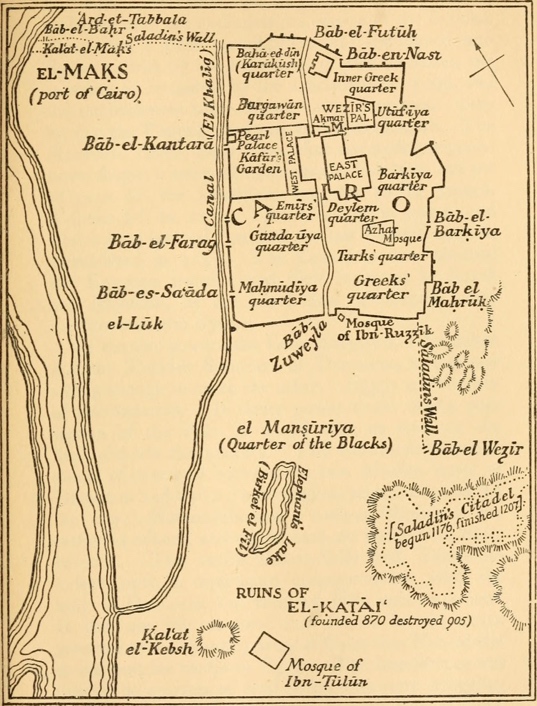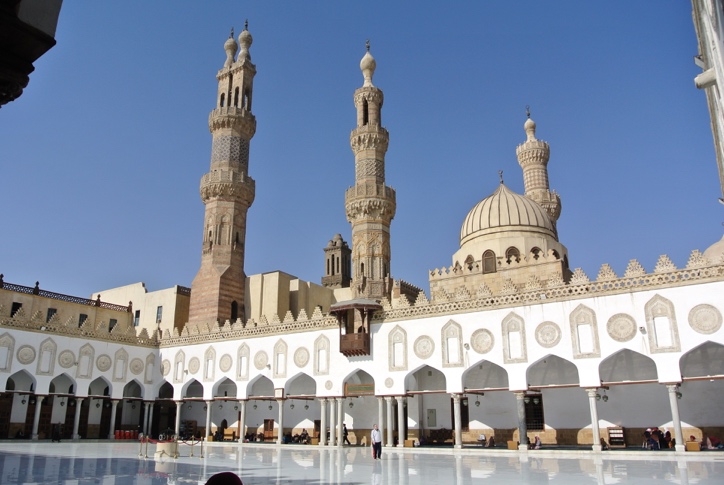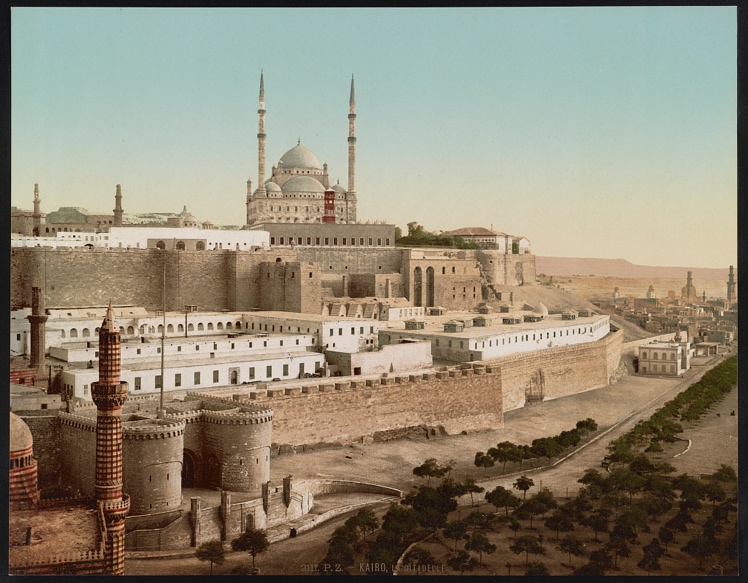Location
The city of Cairo (al-Qāhira in Arabic) was founded in 969 CE, and currently has around 20 million people in the greater metropolitan area. The Qalawun charitable endowment complex is located in the Bayn al-Qaṣrayn section of the city’s Historic (a.k.a. Islamic) Cairo district. The Fatimid Caliphate (909–1171), an Ismaili Shia caliphate, emerged in Ifrīqīya (now Tunisia) in North Africa, standing in opposition to the Sunni Abbasid Caliphate (750–1258) based in Baghdad, and sending repeated military expeditions to the east. In 969, al-Mu‘izz, the fourth Fatimid Caliph (reigned 953–975), took advantage of turmoil in Egypt’s Ikhshidid dynasty (935–969) to send General Jawhar “the Sicilian” on a military expedition to Egypt. The Fatimid army conquered Egypt with little resistance, and Jawhar decided to build a new Fatimid capital to house the Caliphate’s royal palace. Jawhar chose to build in the area now known as the Historic (Islamic) Cairo district. Jawhar named the new capital “al-Qāhira“, which means “the city of victory” in Arabic. “Cairo” is the European pronunciation of this name.
Fatimid era Cairo was a small walled city 1100 meters east-to-west and 1150 meters north-to-south. The central thoroughfare al-Mu‘izz li-Din Allāh Street, or al-Mu‘izz Street for short, ran from Futūḥ Gate in the north to Zuweila Gate in the south. Along the middle section of al-Mu‘izz Street, the eastern and western royal palaces were built on either side. These became the seat of the Fatimid Caliphate. Between the two palaces there was a ceremonial square called Bayn al-Qaṣrayn (“Between the Two Palaces”). The Qalawun complex is located on the west side of the square, on the site of the western palace.
Source: Stanley Lane-Poole, 1905: 184.
Image source: Internet Archive Book Images (https://www.flickr.com/photos/internetarchivebookimages/14782234955/)

Cairo was initially built exclusively for the palaces, military barracks, and mosques. Only certain people could live there. In 970, al-Azhar Mosque was built southeast of the eastern palace. It served as an Ismaili Shiite teaching base for the Fatimid dynasty. Upon visiting Egypt in 1047, Iranian Nāṣir Khusraw (died 1061) described Cairo as having more than 20,000 stores and countless caravanserais (roadside inns) and bathhouses. This shows that, just 70 years later, Cairo had become a bustling city.

In 1169, Saladin (a.k.a. Salah ad-Din, reigned 1169–93) was appointed as vizier of the Ismaili Shiite caliphate’s Fatimid dynasty, which he soon after abolished and replaced with the Sunni Ayyubid dynasty (1169–1250). He built a citadel high on the Mokattam (Muqaṭṭam) hills southeast of Cairo, establishing a new political, bureaucratic, and military base. With the space inside the Fatimid-built city walls exposed to the fortress above, it effectively ceased to function as a base of political power. Intending to revive Sunni Islam, Saladin also stopped the al-Azhar Mosque from functioning as a Friday gathering place and providing lectures on Ismaili Shia Islam. Moreover, the Fatimid royal palace library (a.k.a. the House of Wisdom), which had functioned as a research and teaching center for Ismaili doctrine, was closed and its book collections were sold.
Nevertheless, the Fatimid-constructed walled city continued to flourish beneath the hilltop fortress of the Ayyubid dynasty. Under the Ayyubids, new city walls were built, extending the city to the banks of the Nile, where water stream moved westward. This shows that Cairo was an expanding city with a growing population.
(Source: Photoglob Co., Publisher. Kairo, la Citadelle. Cairo Cairo. Egypt, ca. 1890. [Zürich: Photoglob Company, to 1910];
Image source: US Library of Congress (https://www.loc.gov/item/2017657143/)

In the Mamluk Sultanate era that followed (1250–1517), mosques, madrasas, caravanserais, sabīls (public water fountains), and other facilities were built one after another through charitable endowments from sultans, influential military personnel, and merchants. Bayn al-Qaṣrayn, which had been a place for ceremonies under the Fatimid Caliphate, evolved into a commercial district with a continuous flow of people and goods. In addition, the Mamluk sultans built large-scale charitable endowment facilities one after another on the site of the former Fatimid palace. Among them was Mamluk Sultan Qalawun, who built a complex including a mausoleum, madrasa, and hospital where the west royal palace of the Fatimid dynasty had once stood. Later, his son Sultan al-Nāṣir Muḥammad (reigned 1294–95, 1299–1309, 1309–1340) built his own similar complex north of his father’s hospital. Also, Sultan Barqūq (reigned 1382–89) built another similar complex to the north of that. Thus, three large complexes built by three Mamluk sultans now stand in a row on the grounds of what was once a Fatimid royal palace.
ArcGIS online:
[http://www.arcgis.com/home/webmap/viewer.html? webmap=da7fac4fe3584bc0a784b5b35a62621a].
The Bayn al-Qaṣrayn section of the main thoroughfare was the perfect place for an imposing display of royal authority. And the grounds of the Fatimid royal palace were a great place to secure land for the construction of huge buildings. Those who saw these stately stone structures with the donor’s name carved on their walls would have sensed the power of the sultans that ruled the Islamic dynasty.
References:
Behrens-Abouseif, Doris. Cairo of the Mamluks: A History of the Architecture and its Culture. (Cairo: American University in Cairo Press, 2007).
Lane-Poole, Stanley. The Story of Cairo. (London: J.M. Dent & Co., 1906).
Sanders, Paula. Ritual, Politics, and the City in Fatimid Cairo. (Albany: State University of New York Press, 1994).
Sato, Tsugitaka. Saladin: The Hero of Islam who fought the Crusaders [in Japanese]. (Kodansha, 1996)
Matsuda, Toshimichi. Saladin: The Recapture of Jerusalem [in Japanese]. (Yamakawa Shuppansha, 2015).
English translation: Jeff Gedert